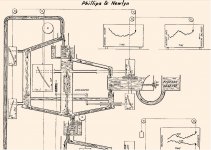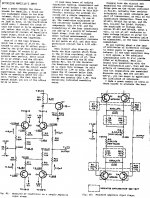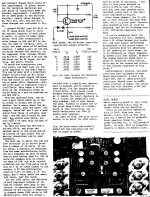Jan, the potential for 'balance' with the Ampzilla should have been easy. However, IF you do NOT match the input part pairs, then you can have trouble. In fact, I suspect that real problems occured, if the emitter degeneration resistors were not added. That is the ONLY reason that I can see that they were added in the first place. Jim B is a good designer, but he does NOT throw money at his parts, and he would use less, if possible. More free lunches, you see. '-)
I was using the complementary differential input stage since 1968, BUT I used factory matched pairs of bipolar transistors, so I did NOT need emitter degeneration, AND I paid the price with a lower slew rate than possible. It was typical of amp design at the time. Check it out. Look at Marantz, etc.
I was using the complementary differential input stage since 1968, BUT I used factory matched pairs of bipolar transistors, so I did NOT need emitter degeneration, AND I paid the price with a lower slew rate than possible. It was typical of amp design at the time. Check it out. Look at Marantz, etc.
Jan, the potential for 'balance' with the Ampzilla should have been easy. However, IF you do NOT match the input part pairs, then you can have trouble. In fact, I suspect that real problems occured, if the emitter degeneration resistors were not added. That is the ONLY reason that I can see that they were added in the first place. Jim B is a good designer, but he does NOT throw money at his parts, and he would use less, if possible. More free lunches, you see. '-)
I was using the complementary differential input stage since 1968, BUT I used factory matched pairs of bipolar transistors, so I did NOT need emitter degeneration, AND I paid the price with a lower slew rate than possible. It was typical of amp design at the time. Check it out. Look at Marantz, etc.
Not my point. JB added the 'balancing emitter degenerations resistors' but it was still unbalanced. Why? He didn't consider the DC current going into the next stage from one side of the diff pair. That current was a significant fraction of half the tail current, so this unbalanced the input pair big time. Of course, diligent matching of input devices doesn't help you diddly here either.
So, clearly, the advise to add degeneration resistors to balance the stage is not wrong but it is only one part of the story, and even supposedly seasoned designers like JB can goof there.
jan
I don't see this as a problem, Jan. I have made worse, and it worked out. The complementary parts tend to push pull each other, for one thing. The differential is secondary. Also, the darlington buffer has maybe 5uA drive needed? Perhaps you can show me where I went wrong.
I don't see this as a problem, Jan. I have made worse, and it worked out. The complementary parts tend to push pull each other, for one thing. The differential is secondary. Also, the darlington buffer has maybe 5uA drive needed? Perhaps you can show me where I went wrong.
I didn't say you went wrong, why do you say that?
It should be clear from my post that I didn't imply something like a 5uA drive, when I said 'a significant fraction of half the tail current'. I don't remember the exact numbers, and honestly I have no intention to get up and spend another half hour to look for it, but if you have a half tail current of 1mA and your next stage takes 350uA clearly, that is a design oversight. I agreed with Walt at the time and still do. I would expect that you would also wholeheartedly agree with that. It makes the cry for matching input devices ridiculous, of course.
jan
John and others, what is your opinion on the class D amplifiers and other similar ones, for example class Z (digital feed-back), etc. ?
The advantages of those designs are well known, but what about the sonic qualities ?
Do they sound good to you ? Or do they have sonic "signatures" (an euphemism for not quite good sound ) ?
) ?
Since they are based on different principles than the linear amplifiers they shouldn't have the dreaded "semiconductor" sound (bipolar or FET sound). On the other hand, they probably won't have the "tube" sound either, so how would one characterize their sound ?
The advantages of those designs are well known, but what about the sonic qualities ?
Do they sound good to you ? Or do they have sonic "signatures" (an euphemism for not quite good sound
Since they are based on different principles than the linear amplifiers they shouldn't have the dreaded "semiconductor" sound (bipolar or FET sound). On the other hand, they probably won't have the "tube" sound either, so how would one characterize their sound ?
Re: evolution of feedback control
Jan, two more links here. Pretty good sum-up
http://siamun.weebly.com/uploads/4/1/7/3/4173241/history_of_automatic_control.pdf
http://userspages.uob.edu.bh/ebrgallaf/00506394.pdf
Regards
George
Jan, two more links here. Pretty good sum-up
http://siamun.weebly.com/uploads/4/1/7/3/4173241/history_of_automatic_control.pdf
http://userspages.uob.edu.bh/ebrgallaf/00506394.pdf
Regards
George
Jan, the issue that you mentioned is: TAA 2/1975 'Kit Report A Construction Report the Taming of Ampzilla'. On p. 16 Walt insists that matching the input devices is really, really important. He even thinks that an serious resistor modification might do the job, if you could not match the parts. Little else seems necessary, except that JB insisted that he later MATCHED the input devices. And so it goes! '-)
I called Walt Jung to get this initial info on the Ampzilla, today. You might follow up with him, as I did.
I called Walt Jung to get this initial info on the Ampzilla, today. You might follow up with him, as I did.
I guess what JB may have done is simply selected a collector load resistor on the basis of his desired LTP gain (i.e. 0.5*re*Rl for a non degenerated pair) and then tapped off to the beta enhanced VAs stage. The loop gain would be high . . . but the LTP balance very suboptimal. With non-miror loaded LTP's, you need to tweak the LTP load resistor to ensure the currents are balanced. As you say Jan, selecting the LTP transistors would do nothing here to resolve the situation.
Attachments
Jan, the issue that you mentioned is: TAA 2/1975 'Kit Report A Construction Report the Taming of Ampzilla'. On p. 16 Walt insists that matching the input devices is really, really important. He even thinks that an serious resistor modification might do the job, if you could not match the parts. Little else seems necessary, except that JB insisted that he later MATCHED the input devices. And so it goes! '-)
I called Walt Jung to get this initial info on the Ampzilla, today. You might follow up with him, as I did.
Yes that's it, thanks for the heads-up. It seems my memory wasn't that correct; I just read the sidebar 'Optimizing Ampzilla's input' on page 16 in that issue. The unbalance apparently was the result, not as I thought from asymetrical laoding, but of rather loose accuracy of the involved resistors (5%) and 4 unmatched input stage transistors. Walt spend several hours to evolve a solution that worked, and it is instructive to read that part; he was already smart at that time
Maybe I should put it on my website if Walt agrees, as a kind of 'case study'.
jan
Jan, two more links here. Pretty good sum-up
http://siamun.weebly.com/uploads/4/1/7/3/4173241/history_of_automatic_control.pdf
http://userspages.uob.edu.bh/ebrgallaf/00506394.pdf
Regards
George
Thanks George; what intrigues me is that for centuries people have been using feedback-based automatic control without have a solid understanding of the concept and stability issues as we have since early last century.
So you can get quite far with intuitive understanding, but then again, only so far.
I've been involved with software for guided missile control and let me tell you, there's not much intuitive about those complex control loops
jan
Thanks George; what intrigues me is that for centuries people have been using feedback-based automatic control without have a solid understanding of the concept and stability issues as we have since early last century.
jan
If it was only for this technical subject
Partial understanding, often missunderstanding is the common scenario in all aspects of life/knowledge.
So you can get quite far with intuitive understanding, but then again, only so far.
Intuition provides the idea.
Then, analysis takes over.
In the last phase when one is lost into the forest of complexity, intuition may be needed again for to provide the bearings
I've been involved with software for guided missile control and let me tell you, there's not much intuitive about those complex control loops
While developing complex control loops software for antimissile control (marriage ), intuition is indispensable
I would like to point out that there are two kinds of 'balance' in a typical discrete audio amp. I might define them as: differential balance and complementary balance.
Without extensive simulation, it is difficult to understand the 'importance' of one over the other, but both tend to cancel even order distortion products, especially in their class A input and voltage drive stage. The best possible approach 'may' be using both approaches, but sometimes, it is not practical. In the case of the Ampzilla, it might have been useful to add a second darlington pair to the second stage, in order to 'differentially balance' the second stage. This general approach can be useful, in fact, the Parasound amp that I am now using, the HCA 2500, uses this approach. However, I have not found it absolutely necessary, and did not put it in the HCA1000, 1200, 3500, or the JC-1 for that matter, and still got good results. The reason is that the complementary aspect of the design provides adequate even order cancellation to do the job. However, if I were going for 'specs', I might make all my amps 'differentially balanced' as well.
Without extensive simulation, it is difficult to understand the 'importance' of one over the other, but both tend to cancel even order distortion products, especially in their class A input and voltage drive stage. The best possible approach 'may' be using both approaches, but sometimes, it is not practical. In the case of the Ampzilla, it might have been useful to add a second darlington pair to the second stage, in order to 'differentially balance' the second stage. This general approach can be useful, in fact, the Parasound amp that I am now using, the HCA 2500, uses this approach. However, I have not found it absolutely necessary, and did not put it in the HCA1000, 1200, 3500, or the JC-1 for that matter, and still got good results. The reason is that the complementary aspect of the design provides adequate even order cancellation to do the job. However, if I were going for 'specs', I might make all my amps 'differentially balanced' as well.
Don't you think that using a mirror loaded LTP to force balance, or, tweaking the LTP resistor load would give you close enough balance? If you are using a beta enhanced VAS stage, then I would imagine with a typical VAS standing current of 10-20mA, the base drive current would be very low - probable less than the 5uA you mention above.
I would like to point out that there are two kinds of 'balance' in a typical discrete audio amp. I might define them as: differential balance and complementary balance.
Without extensive simulation, it is difficult to understand the 'importance' of one over the other, but both tend to cancel even order distortion products, especially in their class A input and voltage drive stage. The best possible approach 'may' be using both approaches, but sometimes, it is not practical. In the case of the Ampzilla, it might have been useful to add a second darlington pair to the second stage, in order to 'differentially balance' the second stage. This general approach can be useful, in fact, the Parasound amp that I am now using, the HCA 2500, uses this approach. However, I have not found it absolutely necessary, and did not put it in the HCA1000, 1200, 3500, or the JC-1 for that matter, and still got good results. The reason is that the complementary aspect of the design provides adequate even order cancellation to do the job. However, if I were going for 'specs', I might make all my amps 'differentially balanced' as well.
Interesting. I was under the impression that the only thing it would do was to increase the OLG by 6dB. Didn't know it changed the distortion profile.
If I understand correctly differential and complementary.
jan
Just so others don't get confused, remember that mirror loading does not enforce LTP balance by itself but also requires DC negative feedback and a rather small VAS input current. Mirror loading on its own simply ensures that LTP balance roughly corresponds to zero LTP output current. I know what you mean, but a newbie reading this thread might not.Bonsai said:using a mirror loaded LTP to force balance
mirrors and complementary pairs/VAS together give the non-obvious problem of indeterminate VAS current - needs additional parts, deliberate design to control the common mode
complementary n/p input devices are always going to be much worse in matching than 2 identical parts of the same polarity in a diff pair
once you have the better (even) harmonic cancellation of a single diff pair adding a complementary diff pair doesn't help (just add a bootstrap cascode to the single diff pair if you think there could be some Zcb cancellation between the complements)
6 dB added gain can be had much more cheaply than duplicating the diff pair input and mirrors
complementary n/p input devices are always going to be much worse in matching than 2 identical parts of the same polarity in a diff pair
once you have the better (even) harmonic cancellation of a single diff pair adding a complementary diff pair doesn't help (just add a bootstrap cascode to the single diff pair if you think there could be some Zcb cancellation between the complements)
6 dB added gain can be had much more cheaply than duplicating the diff pair input and mirrors
- Status
- Not open for further replies.
- Home
- Member Areas
- The Lounge
- John Curl's Blowtorch preamplifier part II


